Introduction to Fibonacci Series.
In my early days, I struggled to understand the Fibonacci sequence as the content provided in my course material needed to be revised to understand. After doing some good research, I am confident enough to take you through the entire journey of the Fibonacci series.
Fibonacci Series or Fibonacci Sequence is one of the hottest topics for learners interested in Mathematics or coding. A rare sequence suggested in Europe has become famous worldwide, and the world started relating to the requirements of the Fibonacci Sequence or the Fibonacci Series. Here in this article, let’s understand all about the Fibonacci sequence.
What is Fibonacci Series | Understand the Fibonacci Sequences
As per mathematics, the Fibonacci number is represented by Fn, forming a series, the Fibonacci sequences, in which each number is the total of the two previous numbers. The Fibonacci numbers are designed in a specific Fibonacci series. These numbers represent the positive (+ve) numbers in a series following a particular structure. The series usually starts from zero(0) & 1, even though few practitioners start the series from 1 and 1 or maybe from 1 and 2(As Fibonacci practiced).
The Fibonacci sequence can go up to infinity. The first few values in the Fibonacci series are given below.
| 0 | 1 | 1 | 2 | 3 | 5 | 8 | 13 | 21 | 34 | 55 | 89 | 144 etc.
History of the Fibonacci Series.
India has been the master of mathematics of all time. Either it is “Zero” given by Aryabhata, or it’s the Fibonacci sequence, as we discuss. The Fibonacci Series first appeared in Indian Mathematics and has a deep connection with Sanskrit poetic tradition. In practice, there was interest in itemizing all patterns of long syllables of 2 unit duration, compared with short syllables of 1 unit duration. Calculating different ways of consecutive L and S with a given calculation duration results in the Fibonacci number: the number of patterns of duration n units is Fn + 1.
The knowledge of the Fibonacci series was proposed during 450 BC- 200 BC in the Maurya era by Acharya Pingala (an ancient Indian mathematician and Sanskrit prosodist). Acharya Pingala’s cryptic formula “misrau cha” (“the two are mixed”) and some other scholars interpreted it in context by explaining that the numbers of the pattern for m defeats (Fm+1) and is secured by adding one number to the Fm cases and one to the Fm−1 point.
Apart from that, even an Ancient famous prosodist, Bharat Muni, also expressed the knowledge of this so-called Fibonacci sequence in his favorite literature called Nayan Shastra from 100BC-c to 350AD. However, the clearest exposition of the series arose in the prosody of Virahanka (an ancient prosodist) during c. 700 AD. His works are lost; however, they are available in some quotations of Raja Gopala (founder of the Pala dynasty of Bihar and Bengal regions of the Indian Subcontinent).
Outside of India, the Fibonacci series first appeared in a book in 1202 called Liber Abaci, which Fibonacci wrote. In this book, the Fibonacci sequence was used to enumerate the growth of the rabbit population. Fibonacci considered the development of an idealized (biologically unrealistic) rabbit population by thinking that: a newborn pair of rabbits are kept in a field, and each team meets at one month of age. After the second month, they breed another pair of rabbits, and the rabbits never die but continue to breed forever.
Fibonacci, also called Leonardo Pisano (English Leonardo of Pisa), original name Leonardo Fibonacci (born c. 1170 —died after 1240), was a medieval Italian mathematician who wrote Liber abaci (1202; “Book of the Abacus“), the first European work on Indian and Arabian mathematics, which introduced Hindu-Arabic numerals to Europe. His name is mainly known because of the Fibonacci sequence.
You can also read:- Finance and Account
How to Use the Fibonacci Sequence
The Fibonacci Sequence follows the rule where every number equals the sum of the former two numbers. These 14 integers are used at the beginning of The Fibonacci series: 0/1/ 1/ 2/ 3/ 5/ 8/ 13/ 21/ 34/ Each number starting with the third, holds to the imposed formula.
The Fibonacci series formula in math can also find a missing term in a Fibonacci sequence. The formula to see the (n+1) term in the series is defined using the recursive procedure.
The Fibonacci formula is given below.
Fn = Fn-1 + Fn-2, where n > 1
Fibonacci Series Number List
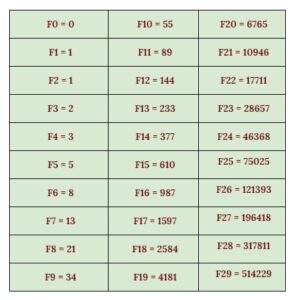
The most common question on the internet is about the number list of the Fibonacci Sequence. The list of numbers goes up to infinity, and Here, I have mentioned the number of the first 30 numbers of the Fibonacci. Sequence.
Fibonacci Series and the Nature
Nature was, is, and will always be the best example of anything you want to learn. After all, this is where we belong. The following are some great examples of the Fibonacci Sequence:
The Fibonacci sequence can be seen as tree branches growing or splitting. The primary root will grow till it produces a branch; the branch then creates two sub-branches.
Now, one of the new stems divides into two, and the other stop growing. This pattern is repeated for each of the new stems.
Fibonacci Series in Math
Though it was started and used initially in a Sanskrit prosody (poem), The Fibonacci Sequence has some good grip over mathematics. Let’s look into the scopes it covers.
Fibonacci Series in Golden Ratio

In mathematics, the Fibonacci sequence and the Golden ratio are connected closely. The Fibonacci series is written as below: 1, 1, 2, 3, 5, 8, 13, 21, 34, 55, 89, 144, 233, 377, 610, 987,
The below syntax explains the relation between both elements.
Fn = (Φn – (1-Φ)n)/√5, where φ is the golden ratio.
The golden ratio is shown as the limit of the ratio of the consecutive condition of the Fibonacci Sequence (or any similar sequence), as described by Kepler in the formula given below,
φ = Lim n→∞ Fn+1/Fn
To explain this, if a Fibonacci number is divided by its antecedent in the provided Fibonacci sequence, the quotient approximates φ. The precision of this value increases with the addition of the value of ‘n,’ i.e., as n goes to infinity.
Fibonacci Series in Pascal’s Triangle
The Fibonacci Sequence has essential applications in Computer Science and Biology, notably in the architecture of plant parts and marine animals. A relation is an equivalence if it’s reflexive, symmetric, and transitive. Pascal’s triangle, in maths, is a triangular array that compromises binomial coefficients.
In a Fibonacci sequence, Fibonacci numbers can be derived from calculating the total components on the rising lines in Pascal’s triangle. We can understand t
his in the image given below; considering the first component ‘0’, the following conditions can be calculated by adding the diagonal elements as shown below:
Fibonacci Series Spiral

Fibonacci numbers can be used to define a spiral. These spirals are observed by various Biologists and Physicists frequently in various natural things and phenomena. As explained in the blog, The branching patterns in plants, leaves, and trees and the spread of seeds in a raspberry reflect the Fibonacci Sequence. There are too many other examples for you to see and relate to how the Fibonacci series has always been around us. I am sure you also will start observing some more examples as you walk on the streets, in a garden, or when you are reading science fiction.
Fibonacci Series and Poetry (FIB)
Fib is explained as experimental Western poetry, similar to haiku, but based on the Fibonacci series. The typical Fib and another version of the modern Western haiku follow a strict structure. It is a copy of how characters were explained in ancient Sanskrit prosodies. A typical Fib is a six-line, 20-syllable poetry with a syllables count by lines of 1/1/2/3/5/8 – with many syllables as required. The line’s place in the Fibonacci series; the ancient form of contemporary haiku uses three or fewer lines and no more than 17 syllables. The only condition on a Fib is that the syllable count follows the Fibonacci Sequence. An example of a typical fib:
One
Small,
Precise,
Poetic,
Spiraling mixture:
Math plus poetry yields the Fib.
Fibonacci Series in Art

Fibonacci used to believe that Mathematics is an art form; according to him, it is an astounding piece of beauty. It has been recognized that the Fibonacci spiral can be the esthetically satisfying principle of expressing appreciation towards an art (Also called – The rule of thirds). This is used in the composition of a picture by applying the balance and features of a third instead of entirely centering the image. By this, a more beautiful and satisfying picture can be achieved.
Application of the Fibonacci Series in different Programming Languages
The Fibonacci Sequence has the potential to crack complex coding algorithms and can be used to write agile coding programs. Here are a few examples to understand how one can write a program to represent the Fibonacci Sequence.
Fibonacci Series in C
// Fibonacci Series in C
#include<stdio.h>
int main()
{
int n1=0,n2=1,n3,i,number;
printf(“Enter the number of elements:”);
scanf(“%d”,&number);
printf(“n%d %d”,n1,n2);//printing 0 and 1
for(i=2;i<number;++i)//loop starts from 2 because 0 and 1 are already printed
{
n3=n1+n2;
printf(” %d”,n3);
n1=n2;
n2=n3;
}
return 0;
}
Output:
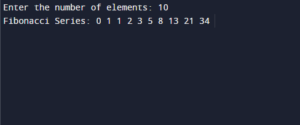
Fibonacci Series using recursion in C
// Fibonacci Series using Recursion in C
#include<stdio.h>
void printFibonacci(int n){
static int n1=0,n2=1,n3;
if(n>0){
n3 = n1 + n2;
n1 = n2;
n2 = n3;
printf(“%d “,n3);
printFibonacci(n-1);
}
}
int main(){
int n;
printf(“Enter the number of elements: “);
scanf(“%d”,&n);
printf(“Fibonacci Series: “);
printf(“%d %d “,0,1);
printFibonacci(n-2);//n-2 because 2 numbers are already printed
return 0;
}
Output:
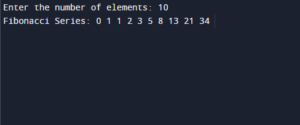
Fibonacci Series in C++
// Fibonacci Series using Recursion in C++
#include <iostream>
using namespace std;
int fib(int x) {
if((x==1)||(x==0)) {
return(x);
}else {
return(fib(x-1)+fib(x-2));
}
}
int main() {
int x , i=0;
cout << “Enter the number of terms of series : “;
cin >> x;
cout << “Fibonnaci Series : “;
while(i < x) {
cout << ” ” << fib(i);
i++;
}
return 0;
}
Output:
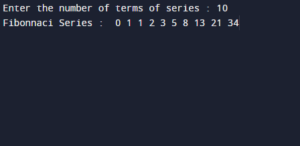
Fibonacci Series in Python
# Fibonacci Series using Recursion in Python
def recur_fibo(n):
if n <= 1:
return n
else:
return(recur_fibo(n-1) + recur_fibo(n-2))
nterms = 10
# check if the number of terms is valid
if nterms <= 0:
print(“Plese enter a positive integer”)
else:
print(“Fibonacci sequence:”)
for i in range(nterms):
print(recur_fibo(I))
Output:
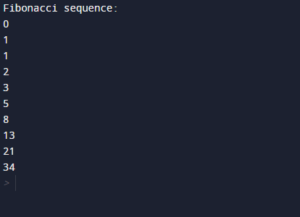
Fibonacci Series in Java
// Fibonacci Series using Recursion in Java
class FibonacciExample2{
static int n1=0,n2=1,n3=0;
static void printFibonacci(int count){
if(count>0){
n3 = n1 + n2;
n1 = n2;
n2 = n3;
System.out.print(” “+n3);
printFibonacci(count-1);
}
}
public static void main(String args[]){
int count=10;
System.out.println(“Fibonacci Series till 10 numbers: “);
System.out.print(n1+” “+n2);//printing 0 and 1
printFibonacci(count-2);//n-2 because 2 numbers are already printed
}
}
Output:
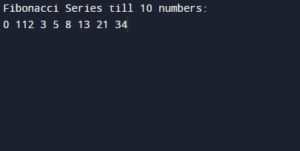
Fibonacci Series in JavaScript
// Fibonacci Series using Recursion in JavaScript
function fibonacci(num) {
if(num < 2) {
return num;
}
else {
return fibonacci(num-1) + fibonacci(num – 2);
}
}
// take nth term input from the user
const nTerms = prompt(‘Enter the number of terms: ‘);
if(nTerms <=0) {
console.log(‘Enter a positive integer.’);
}
else {
for(let i = 0; i < nTerms; i++) {
console.log(fibonacci(i));
}
}
You can also learn this our other blog related to your niche:- Cloud Computing and Data Science & Artificial Intelligence
Summary
It started with Sanskrit poetry and got famous worldwide with its excellent scope of capturing numbers with bigger problem statements; the Fibonacci sequence has been quite a journey. Fibonacci introduced this calculation to address an unrealistic problem of Rabbit breeding. It has traveled through a part of intelligent coding and agile development ideas.
We have discovered how nature has adapted the golden ratio or the Fibonacci sequence. We have seen how an artist can make good use of the Fibonacci spiral, and we have also seen how it traveled from the east to the west and got promoted worldwide.
To summarize, The Fibonacci Sequence has essential applications in Computer Science and Biology, notably in the architecture of plant parts and marine animals.
The Fibonacci number is referred to as Fn, forming a series, the Fibonacci sequence, in which every number is the total of the two preceding numbers.
References: Wikipedia
Watch many tech space-related videos and review of almost every course on our Youtube channel.
Frequently Asked Questions
1. Which is the Fibonacci series?
The Fibonacci number is denoted Fn, forming a series, the Fibonacci series, in which every number is the total of the two preceding numbers.
2. What is the Fibonacci Series formula?
The Fibonacci series formula in math can also be used to find a missing term in a Fibonacci sequence. The formula to see the (n+1) term in the series is defined by using the recursive procedure.
The Fibonacci formula is given below.
Fn = Fn-1 + Fn-2, where n > 1.
3. What are the examples of the Fibonacci sequence in nature?
Nature is filled with examples of the Fibonacci sequence Flower petals, seed heads, pine cones, Sunflower etc. are some examples of how the golden ratio makes things beautiful naturally.
4. Why is it called the Fibonacci sequence?
The sequence of numbers in which the next number is the sum of the previous two numbers is called the Fibonacci sequence. This calculation was derived from ancient Indian calculations.
Since this calculation was introduced to the west and the rest of the world by Fibonacci (Leonardo Fibonacci), It is called the Fibonacci sequence.
5. Why is the Fibonacci sequence important?
There are too many examples available based on the Fibonacci sequence and the golden ratio, which can be seen everywhere in nature around us. Mother Nature is connected to Mathematics. If one wants to observe nature and how new leaves are grown in a plant’s petals and stems, one will notice that it grows in a pattern following the Fibonacci sequence. It becomes an essential parameter for biologists and physicists to help research mother nature.
6. What is the Fibonacci series used for?
The Fibonacci sequence is used for many search algorithms in coding and agile development methods. It plays a significant role in research purposes as well in various different sectors. Several biologists and physicists also use this sequence as a comparison method in observing nature science.
7.What is a Fibonacci series formula in C?
Here is the program to list Fibonacci sequences up to a number of your choice.
// Fibonacci Series using Recursion in C
#include<stdio.h>
void printFibonacci(int n){
static int n1=0,n2=1,n3;
if(n>0){
n3 = n1 + n2;
n1 = n2;
n2 = n3;
printf(“%d “,n3);
printFibonacci(n-1);
}
}
int main(){
int n;
printf(“Enter the number of elements: “);
scanf(“%d”,&n);
printf(“Fibonacci Series: “);
printf(“%d %d “,0,1);
printFibonacci(n-2);//n-2 because 2 numbers are already printed
return 0;
}
8. How does Fibonacci relate to life?
In Many ways, nature and humans have become examples of great mathematical examples. We can observe that many of the natural things follow the Fibonacci sequence. It appears in biological setups such as branches in a tree, the stems and the growth of a new leaf, the sprouts of a pineapple, the flowering of a sunflower, and many other naturally grown objects.
9. How do you read (pronounce) Fibonacci?
fi·buh·naa·chee.
The Fibonacci sequence follows a strict rule that every number is equal to the sum of the previous two numbers
The Nth in Fibonacci sequence is the Sum of the previous two numbers (Nth-1) and (Nth-2).
11. What is the Fibonacci of 13?
The 13th number of Fibonacci sequence is 144, as it starts with o and 1 and goes up, adding the last 2 preceding.
Yes, as per the old Fibonacci sequence, zero was the beginning of it, however in many modern sequences, the zero is missing and it starts with one(1) and based on that, the place value of the sequence numbers also change.













